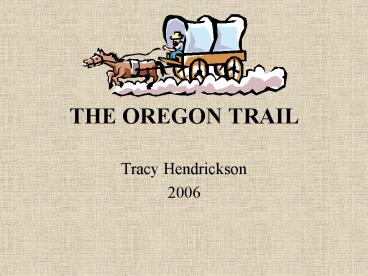THE OREGON TRAIL - PowerPoint PPT Presentation
1 / 20
Title: THE OREGON TRAIL
1
THE OREGON TRAIL
- Tracy Hendrickson
- 2006
2
Objectives
- Students will be able to summarize the events in
westward expansion, including peoples
motivation, their hardships, and Missouri as a
jumping off point to the west.
3
Oregon Territory
- Made up of what is now
- A. Oregon
- B. Washington
- C. Idaho
- D. Parts of Montana
- E. Parts of Wyoming
4
Reasons for Heading West
- Free land
- Economic Opportunities
- Fur trade
- Adventure
- To find gold
- Religious Freedom
- Excellent farmland
5
Covered Wagon
- Waterproof canvas top
- Wheels smaller in the front to make sharp turns
easier. - Pulled by oxen (stronger)
- Prairie Schooner looked like boats sailing
across the grassy green waves
6
Wagon Trains
- Group of covered wagons heading west together
- Leader selected to make major decisions
- Council met to discuss and report on different
problems
7
Trail Guide
- Fur trappers and traders who had made the trip
before - Knew the best ways to travel the trails
8
Things to take on the Trail
- Flour yeast
- Water
- Seeds
- Candles
- Household utilities
- Guns
- Ammunition
- Favorite dishes
- Family pictures
- Childrens favorite toys
- Clothing
- Notions
- Tools
- blankets
9
Jumping Off
- Refers to the location where preparations for the
journey to Oregon Country began. - Many travelers would join a wagon train
- The trails west started in these cities in
Missouri - Independence
- Westport Landing (now part of Kansas City)
- St. Joseph
10
Best Time to Travel
- Too Early Spring rains caused trail to become
to muddy wagon wheels get stuck. - Too Early grass wouldnt be tall enough for the
oxen and cattle. - Too Late Cross mountain in early winter
snowstorms - Perfect time After the spring rains when the
sun was shining and grass was growing tall
11
Crossing Rivers
- Large flat boats called scows would carry wagons
across rivers - Horses, cows, and oxen had to swim
- Indian rafts
- Seal wagon with tar candle wax mixed with ashes
12
Dangers Difficulties
- Mud (wagon wheels stuck)
- Ground too dry (dust)
- Sicknesses
- Children and Adults injured or killed by wagon
- Dangerous mountain passages
- Unfriendly, hostile Indians (steal cattle
horses)
13
Children Chores
- Milk cows
- Get water from river
- Watch cattle
- Help cook
- Wash dishes
- Help skin prepare buffalo or deer
- Collect wood or buffalo chips
- Shake out blankets quilts
- Hang beef jerky to dry
14
Animals on the Trail
- Buffalo
- Prairie dogs
- Rattlesnakes
- Owls
- Wolves
- Coyotes
- Jackrabbits
- Wild turkeys
- Sage hens
- Lizards
- antelope
15
How did they get more supplies along the trails?
- Forts
- Ft. Laramie (40 days to reach it)
- Ft. Bridger (up to 30 more days)
- Ft. Hall
- Indians trade
- Trade with other pioneers
16
Wagons Over Mountains
- Oxen
- Tie rope to back of wagon, other end to a tree,
and PULL!
17
Landmarks Used for Direction
- Chimney Rock (Nebraska)
- Independence Rock (Wyoming)
- Soda Springs
- Steamboat Springs
- Devils Backbone
- Continental Divide (wagons would cross at South
Pass halfway Oregon!)
18
Fantastic Facts
Tidbits
19
Activities
20
Credits, Citations, References
- http//www.isu.edu/7Etrinmich/Oregontrail.html
- Missouri Now and Then, McCandless, Perry
William E. Foley. University of Missouri Press,
Columbia, 2001. - If You Traveled West in a Covered Wagon. Levine,
Ellen. Scholastic, 1986. - Appleseeds Growing Up on the Oregon Trail.
September 1999. Buckley, Susan and Barbara
Burt. Cobblestone Publishing Company. - History Comes Alive Teaching Unit Pioneers.
Moger, Susan. Scholastic Professional Books,
2000.































